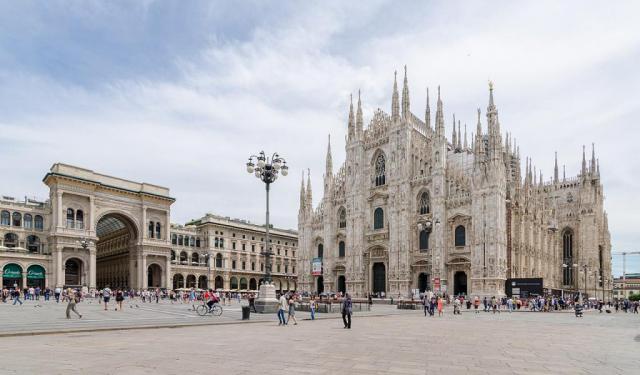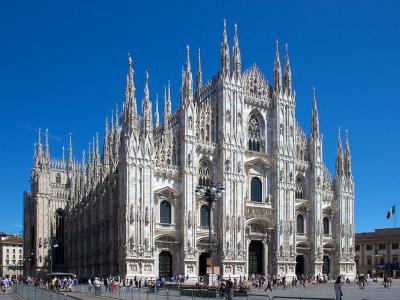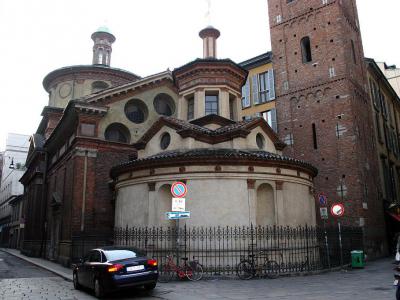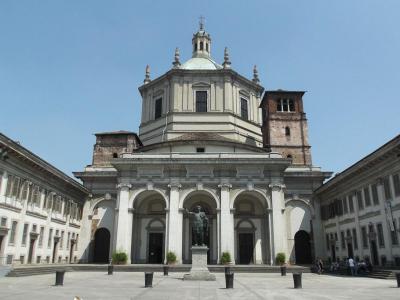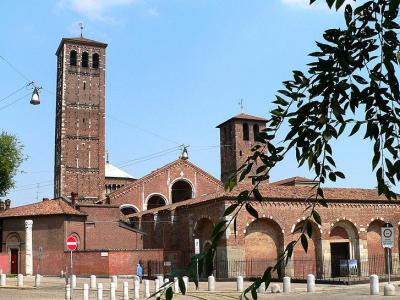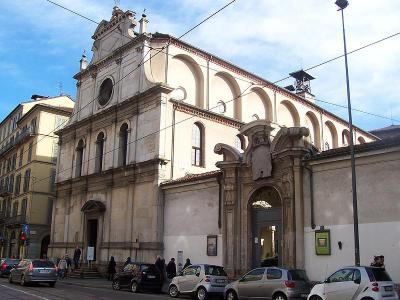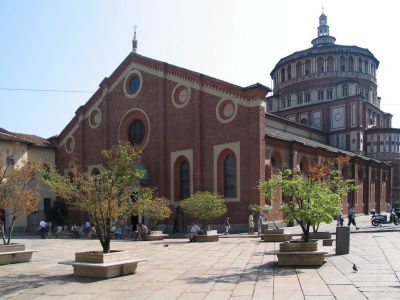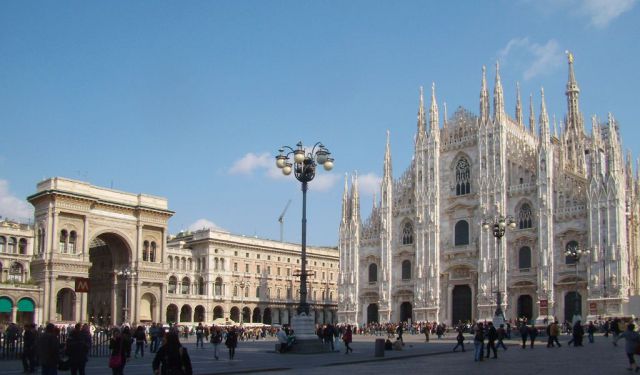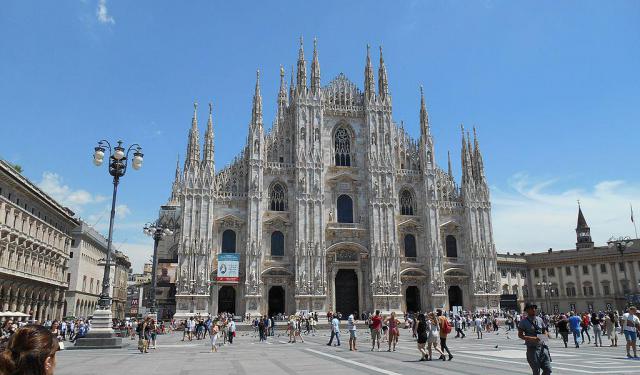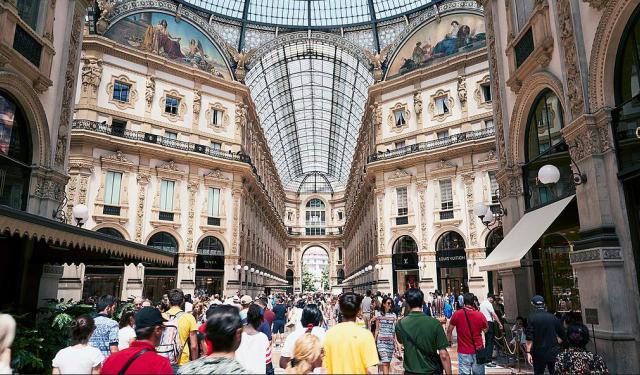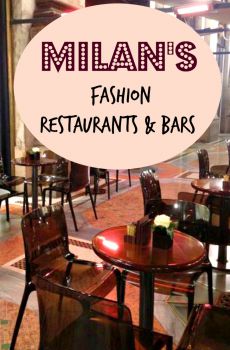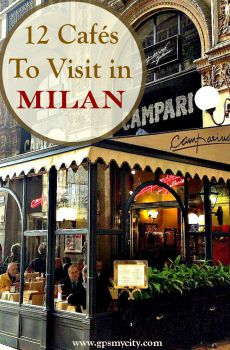Historical Churches Walking Tour (Self Guided), Milan
Milan may well be a world fashion capital and one of the financial capitals of Europe, but religion, and particularly churches, are an inseparable part of the Milanese life. Indeed, steeped in history, this city has garnered over the centuries a wealth of iconic places of worship.
Among these, the Milan Cathedral (Duomo di Milano) stands as a symbol of grandeur and faith. This magnificent Gothic temple, with its intricate spires and stunning façade, took over 600 years to complete, making it a testament to the enduring dedication of its builders.
Moving through the city's religious landmarks, you may come across the Church of Saint Mary near Saint Satyrus (Chiesa di Santa Maria presso San Satiro), a small gem hidden within Milan's bustling streets. This church is notable for its unique architectural trompe-l'oeil, creating an illusion of space that captivates visitors.
The Basilica of St. Lawrence, the oldest church in Milan, is a historical treasure dating back to the 4th century. Its Early-Christian beauty and the nearby Columns of Saint Lawrence (Colonne di San Lorenzo) attest to Milan's ancient roots.
Basilica of St. Ambrose, named after Saint Ambrose, the city's patron saint, exudes a sense of tranquility amid the urban hustle. The stunning mosaics found within make it a must-visit site for ecclesiastical art enthusiasts.
The Church of St. Maurice, often referred to as the "Sistine Chapel of Milan," boasts mesmerizing frescoes that adorn its interior, offering a glimpse into the city's artistic legacy.
Lastly, the Church of Holy Mary of Grace (Chiesa di Santa Maria delle Grazie) holds Leonardo da Vinci's eternal masterpiece "The Last Supper," a priceless artistic treasure that draws visitors from all over the world.
If you find yourself in Milan, make sure to spare some time to explore these churches which are more than just places of worship but the living museums narrating the city's captivating story. A unique chance to appreciate the sacred artistry of this vibrant city.
Among these, the Milan Cathedral (Duomo di Milano) stands as a symbol of grandeur and faith. This magnificent Gothic temple, with its intricate spires and stunning façade, took over 600 years to complete, making it a testament to the enduring dedication of its builders.
Moving through the city's religious landmarks, you may come across the Church of Saint Mary near Saint Satyrus (Chiesa di Santa Maria presso San Satiro), a small gem hidden within Milan's bustling streets. This church is notable for its unique architectural trompe-l'oeil, creating an illusion of space that captivates visitors.
The Basilica of St. Lawrence, the oldest church in Milan, is a historical treasure dating back to the 4th century. Its Early-Christian beauty and the nearby Columns of Saint Lawrence (Colonne di San Lorenzo) attest to Milan's ancient roots.
Basilica of St. Ambrose, named after Saint Ambrose, the city's patron saint, exudes a sense of tranquility amid the urban hustle. The stunning mosaics found within make it a must-visit site for ecclesiastical art enthusiasts.
The Church of St. Maurice, often referred to as the "Sistine Chapel of Milan," boasts mesmerizing frescoes that adorn its interior, offering a glimpse into the city's artistic legacy.
Lastly, the Church of Holy Mary of Grace (Chiesa di Santa Maria delle Grazie) holds Leonardo da Vinci's eternal masterpiece "The Last Supper," a priceless artistic treasure that draws visitors from all over the world.
If you find yourself in Milan, make sure to spare some time to explore these churches which are more than just places of worship but the living museums narrating the city's captivating story. A unique chance to appreciate the sacred artistry of this vibrant city.
How it works: Download the app "GPSmyCity: Walks in 1K+ Cities" from Apple App Store or Google Play Store to your mobile phone or tablet. The app turns your mobile device into a personal tour guide and its built-in GPS navigation functions guide you from one tour stop to next. The app works offline, so no data plan is needed when traveling abroad.
Historical Churches Walking Tour Map
Guide Name: Historical Churches Walking Tour
Guide Location: Italy » Milan (See other walking tours in Milan)
Guide Type: Self-guided Walking Tour (Sightseeing)
# of Attractions: 6
Tour Duration: 2 Hour(s)
Travel Distance: 3.1 Km or 1.9 Miles
Author: DanaOffice
Sight(s) Featured in This Guide:
Guide Location: Italy » Milan (See other walking tours in Milan)
Guide Type: Self-guided Walking Tour (Sightseeing)
# of Attractions: 6
Tour Duration: 2 Hour(s)
Travel Distance: 3.1 Km or 1.9 Miles
Author: DanaOffice
Sight(s) Featured in This Guide:
- Duomo di Milano (Milan Cathedral)
- Chiesa di Santa Maria presso San Satiro (Church of St. Mary near St. Satyrus)
- Basilica di San Lorenzo (Basilica of St. Lawrence - oldest church in Milan)
- Basilica di Sant'Ambrogio (Basilica of St. Ambrose)
- Chiesa di San Maurizio al Monastero Maggiore (Church of St. Maurice)
- Chiesa di Santa Maria delle Grazie (Church of Holy Mary of Grace); "The Last Supper" fresco
1) Duomo di Milano (Milan Cathedral) (must see)
The Milan Cathedral, otherwise known as the Duomo, is the seat of the Archbishop of Milan and the largest church in Italy (the third largest in Europe and the fourth largest in the world), covering an area of 12,000 sqm and weighing a staggering 325,000 tons!
The cathedral is dedicated to Saint Mary Nascent and has been the epicenter of the city's life since 1386. Its foundation was laid by Gian Galeazzo Visconti, who died in 1402 when only half of the structure had been finished, upon which the construction came to a standstill for almost 80 years because of the lack of funds and ideas. It resumed only in 1500, and by 1510 the octagonal dome was completed – embellished with four series of 15 statues representing different characters from the Bible.
In 1805, Napoleon Bonaparte forced completion of the façade, which overall took another seven years of work. In honor of his efforts, a statue of Napoleon was erected at the top of one of the spires. Later, the Duomo also hosted his crowning ceremony. However, it wasn't until the 20th century, with the completion of the last gate, that the centuries-long construction of the cathedral was finally over, marked by inauguration on January 6, 1965.
A climb to the roof, much as a descend to the Paleo Christian baptistery beneath the west side of the Duomo are the highlights of a visit here. The rooftop offers a closer look at the intricate details of the spires and the gargoyles adorning it, plus a breathtaking view over of the city, some 70 meters above ground, replete with myriads of statues, pinnacles, tracery and flying buttresses. In order to get there, visitors have to traverse 201 stairs up through a winding narrow passageway, which is a bit tiring. Still, those who wish, can spare the effort and use an elevator.
Why You Should Visit:
Milan's one truly must-visit sight – a vast riot of ornate religious sculpture on the exterior, and the interior sublimely huge.
Tip:
Buy an online skip-the-line ticket that covers entry and access to the elevator.
The surrounding piazza comes at its finest at night when the cathedral's façade is lit by white lights.
The cathedral is dedicated to Saint Mary Nascent and has been the epicenter of the city's life since 1386. Its foundation was laid by Gian Galeazzo Visconti, who died in 1402 when only half of the structure had been finished, upon which the construction came to a standstill for almost 80 years because of the lack of funds and ideas. It resumed only in 1500, and by 1510 the octagonal dome was completed – embellished with four series of 15 statues representing different characters from the Bible.
In 1805, Napoleon Bonaparte forced completion of the façade, which overall took another seven years of work. In honor of his efforts, a statue of Napoleon was erected at the top of one of the spires. Later, the Duomo also hosted his crowning ceremony. However, it wasn't until the 20th century, with the completion of the last gate, that the centuries-long construction of the cathedral was finally over, marked by inauguration on January 6, 1965.
A climb to the roof, much as a descend to the Paleo Christian baptistery beneath the west side of the Duomo are the highlights of a visit here. The rooftop offers a closer look at the intricate details of the spires and the gargoyles adorning it, plus a breathtaking view over of the city, some 70 meters above ground, replete with myriads of statues, pinnacles, tracery and flying buttresses. In order to get there, visitors have to traverse 201 stairs up through a winding narrow passageway, which is a bit tiring. Still, those who wish, can spare the effort and use an elevator.
Why You Should Visit:
Milan's one truly must-visit sight – a vast riot of ornate religious sculpture on the exterior, and the interior sublimely huge.
Tip:
Buy an online skip-the-line ticket that covers entry and access to the elevator.
The surrounding piazza comes at its finest at night when the cathedral's façade is lit by white lights.
2) Chiesa di Santa Maria presso San Satiro (Church of St. Mary near St. Satyrus)
Located near the Duomo, at the beginning of Via Torino, the shopping street, lies one of Milan's hidden gems: the Church of Saint Mary near Saint Satyrus, with its optically illusional, false apse – an early example of trompe-l'œil, attributed to Donato Bramante.
Founded by Archbishop Ansperto in the 9th century, the church is dedicated to Saint Satyrus, the brother of Saint Ambrose (Milan's patron saint), and was built in the second half of the 15th century to house a miraculous icon: a votive painting of the Madonna and Child.
Due to limited space for building the church, architect Donato Bramante had to devise an illusionistic solution to give the visitor the impression that the apse, which houses the image of the Madonna, is 9.70 meters deep, covered by a barrel vault with coffering. In reality, the apse occupies only 97 centimeters of depth: a painted stucco fake choir creates an optical illusion that is revealed only by standing to the side of the altar.
Though architectural optical illusion was popular in the late Renaissance and Baroque, Bramante gave it an entirely new dimension, with special lighting inside the church was used to help create the desired effect.
Why You Should Visit:
There aren't many places like this in Milan: small, half-hidden, and ready to reveal themselves only to those who know how to discover them.
Entry is free and photos are allowed, so you can easily have a look at the views of its interior. The perspective effect at the end is simply stunning.
Tip:
One of the most beautiful views of the church from the outside is the back, between via Falcone and via Speronari: the chapel of Saint Satyrus, older than the main church and detached from it, is a masterpiece of decorations in terracotta and turrets.
Founded by Archbishop Ansperto in the 9th century, the church is dedicated to Saint Satyrus, the brother of Saint Ambrose (Milan's patron saint), and was built in the second half of the 15th century to house a miraculous icon: a votive painting of the Madonna and Child.
Due to limited space for building the church, architect Donato Bramante had to devise an illusionistic solution to give the visitor the impression that the apse, which houses the image of the Madonna, is 9.70 meters deep, covered by a barrel vault with coffering. In reality, the apse occupies only 97 centimeters of depth: a painted stucco fake choir creates an optical illusion that is revealed only by standing to the side of the altar.
Though architectural optical illusion was popular in the late Renaissance and Baroque, Bramante gave it an entirely new dimension, with special lighting inside the church was used to help create the desired effect.
Why You Should Visit:
There aren't many places like this in Milan: small, half-hidden, and ready to reveal themselves only to those who know how to discover them.
Entry is free and photos are allowed, so you can easily have a look at the views of its interior. The perspective effect at the end is simply stunning.
Tip:
One of the most beautiful views of the church from the outside is the back, between via Falcone and via Speronari: the chapel of Saint Satyrus, older than the main church and detached from it, is a masterpiece of decorations in terracotta and turrets.
3) Basilica di San Lorenzo (Basilica of St. Lawrence - oldest church in Milan)
One cannot help but be struck by the seemingly hodgepodge array of towers, lodges, apses and domes that make up this often overlooked architectural landmark. Despite its unconventional appearance, this basilica, established in the 4th century, was actually one of the largest church buildings in all of Europe at the time. The mammoth blocks used for its foundation were taken from other Roman sites, and its interior is uniquely adorned with marble on the lower half and mosaics on the upper.
The chapel, with its octagonal structure, is considered to be one of the most magnificent examples of this style among the remaining Roman octagonal buildings, having played a fundamental role in the history of western art and architecture and having been imitated many times.
A remnant of a Romanesque atrium leads visitors to the heart of the church, where sixteen ancient Roman columns stand guard, now serving as a favorite hangout spot for young couples. The most precious treasures, however, are the fragments of aforementioned mosaics that once adorned the entire structure.
Tip:
Behind the chapel altar you can descend a flight of stairs to view the foundations laid down in Roman times.
The chapel, with its octagonal structure, is considered to be one of the most magnificent examples of this style among the remaining Roman octagonal buildings, having played a fundamental role in the history of western art and architecture and having been imitated many times.
A remnant of a Romanesque atrium leads visitors to the heart of the church, where sixteen ancient Roman columns stand guard, now serving as a favorite hangout spot for young couples. The most precious treasures, however, are the fragments of aforementioned mosaics that once adorned the entire structure.
Tip:
Behind the chapel altar you can descend a flight of stairs to view the foundations laid down in Roman times.
4) Basilica di Sant'Ambrogio (Basilica of St. Ambrose)
Saint Ambrose, Milan's patron saint and one-time superstar bishop, is buried in the crypt of this red-brick cathedral, which he founded in 379 CE. It's a fitting legacy, built and rebuilt with a purposeful simplicity that is truly uplifting: the seminal Lombard Romanesque basilica, considered to be one of the most ancient churches in Italy and one of the most historically interesting medieval buildings in Lombardy.
Over the years, the cathedral has undergone several restorations and partial reconstructions, culminating in its current appearance in the 12th century. The structure is adorned with two bell towers: the right one, called dei Monaci ("of the Monks"), dates back to the 9th century, and exudes a defensive severity typical of such structures. The left tower, higher than the former, was constructed in 1144, with the last two floors added in 1889.
As you step inside, you will be greeted by shimmering altar mosaics and a biographical golden altarpiece that once clad the saint's sarcophagus. The shadowy vaulted interior of the cathedral is brilliantly illuminated by these stunning artworks, taking visitors on a journey back in time to a bygone era.
Why You Should Visit:
The impressive architecture is best to be seen from afar and you won't be disappointed at entering. You won't find fancy, elaborate gilded decorations but will be able to see 6th-century columns, a 4th-century mosaic, a 10-century ciborium, medieval statues, Renaissance frescoes and a magnificent golden altar from the year 835.
Over the years, the cathedral has undergone several restorations and partial reconstructions, culminating in its current appearance in the 12th century. The structure is adorned with two bell towers: the right one, called dei Monaci ("of the Monks"), dates back to the 9th century, and exudes a defensive severity typical of such structures. The left tower, higher than the former, was constructed in 1144, with the last two floors added in 1889.
As you step inside, you will be greeted by shimmering altar mosaics and a biographical golden altarpiece that once clad the saint's sarcophagus. The shadowy vaulted interior of the cathedral is brilliantly illuminated by these stunning artworks, taking visitors on a journey back in time to a bygone era.
Why You Should Visit:
The impressive architecture is best to be seen from afar and you won't be disappointed at entering. You won't find fancy, elaborate gilded decorations but will be able to see 6th-century columns, a 4th-century mosaic, a 10-century ciborium, medieval statues, Renaissance frescoes and a magnificent golden altar from the year 835.
5) Chiesa di San Maurizio al Monastero Maggiore (Church of St. Maurice) (must see)
The Church of Saint Maurice is a stunning church in Milan's city center, located where the most important convent for women once stood. With its beautiful murals, it is considered by many to be the most beautiful church in Milan, surpassing even the famous Duomo. Inside, every inch is covered with color, whether through paintings or mosaics, and gold is everywhere. The pillars, ceilings, and walls are adorned with decorations and prints, earning the church its nickname, "The Sistine Chapel" of Milan.
Construction of the church took about fifteen years in the 16th century. It was originally divided into two parts, one for the nuns and one for the faithful, with the strict division having only disappeared at the end of the 18th century.
Many frescoes on the walls date back to the 16th century and include works by Luini (both father and son), Campi, and Peterzano. They depict various religious images, including saints, angels, Jesus carrying the cross, and Jesus when he died. Another noteworthy object is the organ in the part where the nuns used to sit, dating back to 1554 and designed by Antegnati.
The use of colors in the church is powerful, and the colored stained glass windows are also worth seeing.
Tip:
Museo Civico Archeologico, a small but lovely archaeological museum, is located in the adjacent monastery. Here, you can admire two ancient Roman watchtowers up close, as well as numerous sculptures and a beautiful maquette spread over three floors.
Construction of the church took about fifteen years in the 16th century. It was originally divided into two parts, one for the nuns and one for the faithful, with the strict division having only disappeared at the end of the 18th century.
Many frescoes on the walls date back to the 16th century and include works by Luini (both father and son), Campi, and Peterzano. They depict various religious images, including saints, angels, Jesus carrying the cross, and Jesus when he died. Another noteworthy object is the organ in the part where the nuns used to sit, dating back to 1554 and designed by Antegnati.
The use of colors in the church is powerful, and the colored stained glass windows are also worth seeing.
Tip:
Museo Civico Archeologico, a small but lovely archaeological museum, is located in the adjacent monastery. Here, you can admire two ancient Roman watchtowers up close, as well as numerous sculptures and a beautiful maquette spread over three floors.
6) Chiesa di Santa Maria delle Grazie (Church of Holy Mary of Grace); "The Last Supper" fresco (must see)
Santa Maria delle Grazie (the Church of Holy Mary of Grace) is a world-famous church and Dominican convent in Milan, included in the UNESCO World Heritage sites list. The Duke of Milan, Francesco I Sforza, ordered the building of Santa Maria delle Grazie in the 15th century. The design of its apse has been attributed to Donato Bramante, who at that time was in the service of the Duchy. While adhering to the overall Gothic style of the convent, he added some Romanesque touches as well.
The church is primarily famous for the mural of The Last Supper (Il Cenacolo Vinciano) found in the refectory of the convent. Created by Leonardo da Vinci for his patron Duke Ludovico Sforza and the Duchess, this 15th-century wall painting was made on a dry wall rather than on wet plaster, and, thus, is not truly a fresco. A fresco cannot be altered as the artist works; therefore, Leonardo decided to paint on the stone wall and then cover it with a sealing layer. The work began to deteriorate a few years after he had finished it. Two early copies of "The Last Supper", thought to be the work of Leonardo's assistant, still exist.
During World War II, on the night of 15 August 1943, an allied aerial bombardment hit the church and the convent. Much of the refectory was destroyed, but some walls survived, including the one holding "The Last Supper", which had been sand-bagged for protection. The preservation works continuously done ever since, and hopefully in the future, are believed to maintain this painting intact for many centuries to come.
Why You Should Visit:
Viewing "The Last Supper" in its own setting will make you feel more appreciative of the single point linear perspective and the 3D effect so cleverly used by Da Vinci.
Tip:
To view "The Last Supper", make sure to book your tickets well in advance on the official website, as they are usually sold out within at least two weeks prior to the sought date.
The church is primarily famous for the mural of The Last Supper (Il Cenacolo Vinciano) found in the refectory of the convent. Created by Leonardo da Vinci for his patron Duke Ludovico Sforza and the Duchess, this 15th-century wall painting was made on a dry wall rather than on wet plaster, and, thus, is not truly a fresco. A fresco cannot be altered as the artist works; therefore, Leonardo decided to paint on the stone wall and then cover it with a sealing layer. The work began to deteriorate a few years after he had finished it. Two early copies of "The Last Supper", thought to be the work of Leonardo's assistant, still exist.
During World War II, on the night of 15 August 1943, an allied aerial bombardment hit the church and the convent. Much of the refectory was destroyed, but some walls survived, including the one holding "The Last Supper", which had been sand-bagged for protection. The preservation works continuously done ever since, and hopefully in the future, are believed to maintain this painting intact for many centuries to come.
Why You Should Visit:
Viewing "The Last Supper" in its own setting will make you feel more appreciative of the single point linear perspective and the 3D effect so cleverly used by Da Vinci.
Tip:
To view "The Last Supper", make sure to book your tickets well in advance on the official website, as they are usually sold out within at least two weeks prior to the sought date.
Walking Tours in Milan, Italy
Create Your Own Walk in Milan
Creating your own self-guided walk in Milan is easy and fun. Choose the city attractions that you want to see and a walk route map will be created just for you. You can even set your hotel as the start point of the walk.
Historic Center Walking Tour
Contained within the area once delimited by the medieval walls, the Centro Storico (historic center) of Milan encompasses the city's perhaps most famous landmarks and tourist attractions. Compact in size, the area is easily distinguishable on the map much as walkable. Here you can find almost everything Milan is famous for, in a close proximity to each other.
The best place to start is... view more
Tour Duration: 2 Hour(s)
Travel Distance: 2.5 Km or 1.6 Miles
The best place to start is... view more
Tour Duration: 2 Hour(s)
Travel Distance: 2.5 Km or 1.6 Miles
Milan Introduction Walking Tour
Recognized as one of the world's four fashion capitals, Milan is also a global hub of design and a key tourist destination. The etymology of the name Milan remains uncertain. One theory holds that the Latin name Mediolanum comes from the Latin words medio (in the middle) and planus (plain).
In 286 the Roman Emperor Diocletian moved the capital of the Western Roman Empire from Rome to... view more
Tour Duration: 2 Hour(s)
Travel Distance: 3.9 Km or 2.4 Miles
In 286 the Roman Emperor Diocletian moved the capital of the Western Roman Empire from Rome to... view more
Tour Duration: 2 Hour(s)
Travel Distance: 3.9 Km or 2.4 Miles
Leonardo da Vinci's Masterpieces
Leonardo da Vinci, one of the greatest Renaissance artists and polymaths in history, left an indelible mark on Milan through several of his masterpieces created in this city over the nearly 20 years that he spent here.
One of the notable places where you can explore the maestro's work is the Ambrosian Library (Biblioteca Ambrosiana), which houses a vast collection of his drawings and... view more
Tour Duration: 1 Hour(s)
Travel Distance: 2.5 Km or 1.6 Miles
One of the notable places where you can explore the maestro's work is the Ambrosian Library (Biblioteca Ambrosiana), which houses a vast collection of his drawings and... view more
Tour Duration: 1 Hour(s)
Travel Distance: 2.5 Km or 1.6 Miles
Best Shopping Streets and Malls
One of the world's four fashion capitals and, as of lately, that of industrial design as well, Milan is renowned internationally as a top shopping destination, where fashion is the second religion. In a city as rich as this one, dedicated to art and pleasure, there's no shortage of options for those accustomed to upscale shopping and favoring bargains.
Amid the plethora of places to... view more
Tour Duration: 2 Hour(s)
Travel Distance: 3.4 Km or 2.1 Miles
Amid the plethora of places to... view more
Tour Duration: 2 Hour(s)
Travel Distance: 3.4 Km or 2.1 Miles
Useful Travel Guides for Planning Your Trip
Milan's Best Aperitivo Venues
Apéritifs usually are alcoholic drinks that are normally served before a meal. But in Milan the Aperitivo can actually become a fun, cheap (but not unchic) dinner with friends or (in a romantic venue) with a date. The all-you-can-eat formula allows you to buy just one drink and serve yourself with...
16 Best Pastry Shops in Milan Italy
Are you looking to satisfy your sweet tooth with genuine, locally-made Italian pastries and drink real “espresso”? This guide covers the best pastry shops/cafes in Milan, the capital of fashion and excellent northern Italian food. Places where one can drink coffee or tea and eat some of the...
Sweet Shops of Milan
This guide will undoubtably make your trip to Milan a sweet one. Most locations are in the city centre, whilst others are set in older headquarters, that boast incredible landmarks and hidden beauties. Milan is habitually associated to fashion and business but has some exquisite examples of art...
Milan's Fashion Restaurants & Bars
Milan is a city well known for luxurious fashion and shopping. With this guide your designer experience doesn't have to end at the stores and boutiques. Almost every major Italian fashion house (as well as a few foreign ones) has entered the food, beverage, or hospitality businesses in Milan,...
Souvenir Shopping Guide: 16 Italian Goods Worth Buying in Milan
Needless to say much about Milan and the things the city is famous for. From fashion and luxury to football and Berlusconi, the list is long. Still, some of the distinctively Milanese items may pass unnoticed to the eye of a stranger, if not caringly pointed in the right direction by a knowledgeable...
10 Cafes To Visit in Milan
The industrial capital of Italy and one of the world's fashion and business centers, today's Milan is teeming with chaotic urban rush on a daily basis. Although it can't compete with Rome in terms of history, art and architecture, there are hidden gems in Milan well worth searching...
The Most Popular Cities
/ view all
